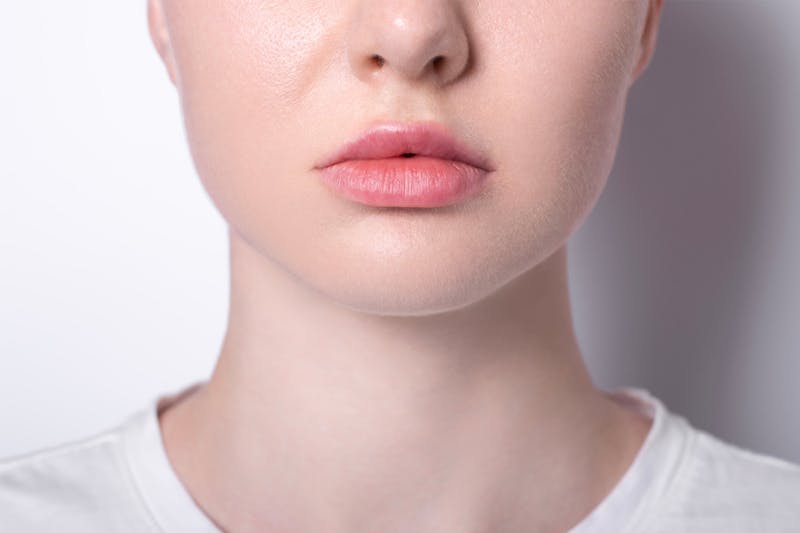
Lip asymmetry is a common aesthetic concern for many individuals, affecting both the appearance and function of the lips. A variety of factors can cause asymmetrical lips and can be addressed through surgical and non-surgical cosmetic procedures.
This guide will provide a comprehensive understanding of lip asymmetry, its causes, and how lip reshaping surgery and other types of procedures can correct it.
Understanding Lip Asymmetry
Lip asymmetry refers to a difference in size, shape, or position between the upper and lower lips. This can manifest as one side of the lip being larger or smaller than the other, or the lips not aligning properly when closed. In some cases, lip asymmetry is subtle and may only be noticeable to the individual. In others, it can be quite pronounced.
Asymmetry can occur due to partial facial paralysis, smile reanimation, or other types of facial paralysis reconstruction. The facial nerve’s 5 primary branches stimulate all the muscles involved in facial expressions.
If any of the 5 main branches of the facial nerve malfunction alone or together, it can cause asymmetric facial features. The objective of asymmetry correction is to achieve facial harmony by addressing asymmetrical features through either reversal or concealment techniques.
Causes of Lip Asymmetry
There are several potential causes of lip asymmetry, ranging from genetic factors to lifestyle habits.
Genetics
The shape and size of our lips can be largely influenced by genetic factors. The structure of our lips is largely influenced by the genes we inherit from our parents. If asymmetrical lips are a common trait that runs in your family, there is a high probability that you will also develop asymmetrical lips.
Facial Features and Structure
The structure of your face can significantly impact your lip symmetry. For example, if your jaw or teeth are misaligned, it can make your lips appear uneven. Orthognathic surgery (corrective jaw surgery) can effectively treat jaw and facial conditions like structural problems, growth issues, sleep apnea, TMJ disorders, malocclusion from skeletal disharmonies, or orthodontic issues not fixed by braces alone.
Medical Conditions
Various medical conditions can cause lip asymmetry, which is a condition where the upper and lower lips are not symmetrical in size, shape, or appearance.
Some of the factors that can cause uneven lips include:
- Bell’s palsy or other forms of facial paralysis: Facial nerve damage can cause the muscles that depress the lip to become paralyzed, leading to lip asymmetry, which can be particularly noticeable when trying to speak or smile.
- Muscle weakness or loss of muscle tone: Underdeveloped facial muscles are usually weak, and this can cause lip unevenness.
- Congenital unilateral lower lip palsy: This is a congenital anomaly that is caused by agenesis or hypoplasia of the depressor anguli oris muscle, a triangular muscle that originates from the mandible and extends to the angle of the mouth. In a majority of cases, left-sided asymmetry is seen, and it can be associated with various congenital abnormalities.
Injury or Trauma
Injuries or trauma to the face can result in asymmetrical lips. This can be due to scarring, nerve damage, or changes in the facial structure following an accident. In such cases, facial surgery can help restore symmetry. For instance, a lip lift can correct the shape, size, and symmetry of the lips. This procedure involves creating an incision either under the nose or at the lip border, removing a small amount of skin, and repositioning the lips for a more desirable appearance.
Lifestyle Habits and Aging Processes
Lifestyle factors, such as smoking, can contribute to lip asymmetry. Smoking can cause premature aging, leading to wrinkles and lines around the lips that can make them appear uneven.
Similarly, the natural aging process can lead to a loss of collagen and elasticity, resulting in sagging and uneven lips.
Sleeping in a position that puts pressure on one side of the face can also contribute to lip unevenness.
Surgical treatments, such as lip augmentation or lip lift, can help address these issues, providing a fuller, more balanced appearance.
Pros & Cons of Surgery for Asymmetrical Lips
Getting surgery to correct asymmetrical lips has both advantages and possible downsides. Therefore, it’s crucial for patients to understand both the potential benefits and the chances of complications in order to make an informed decision.
Benefits of Surgery
Treatment for lip asymmetry often involves craniofacial plastic surgery and facial asymmetry correction, which can restore balance to the face and improve the appearance of the lips. Lip reshaping surgery can also help to correct this cosmetic concern. These procedures involve making an incision and reshaping the lips to alter their look, providing a more even, symmetrical appearance.
Surgical procedures also offer long-lasting results that don’t require additional treatments, making them a beneficial choice for many individuals.

Potential Risks
As with any surgical procedure, there are some risks to consider with surgery for asymmetrical lips. Potential risks include infection at the surgery site, visible scarring from the procedure, and negative reactions to the anesthesia used.
There is also a chance that the final results after healing may not match up to the patient’s hopes. For these reasons, it is very important to thoroughly discuss the potential risks and complications with a qualified surgeon prior to deciding whether to move forward with the surgery.
Other Treatment Options for Correcting Lip Asymmetry
Aside from surgery, there are other common treatment methods available for correcting lip asymmetry. Non-surgical solutions include lip fillers, which can add lip volume and improve facial symmetry without the need for lip surgery.
Lip fillers provide quick and easy treatment with results that last for six months to a year. Several lip filler options are available, including Juvederm and Restylane. The choice between a lip lift and lip fillers depends on the degree of asymmetry and individual goals for appearance.
Talk with an Expert in Facial Plastic Surgery
If you’re considering treatment for lip asymmetry, it’s crucial to consult with an expert in facial plastic surgery. A skilled and experienced surgeon can provide a thorough evaluation, discuss your cosmetic treatment options, and help you make an informed decision.
Dr. Andre Panossian is a board-certified plastic surgeon based in Pasadena, with a focus on facial plastic surgery and reconstructive surgery. He has extensive experience in treating facial asymmetry and has helped many patients achieve a balanced and harmonious smile.
Dr. Panossian’s approach to treatment is individualized, taking into account various factors, including the degree of lip unevenness, the patient’s age, and their personal goals for appearance. He offers a range of surgical and non-surgical treatment options, including surgical lip lift, lip fillers, fat injections, and cosmetic tattooing.
For more information or to schedule a consultation, contact Dr. Panossian’s office at 626-765-6885.


